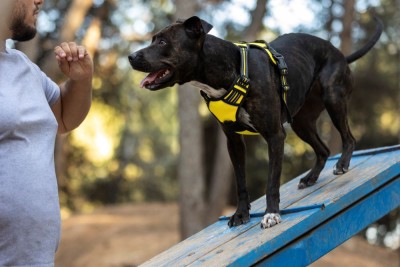
Training your dog is one of the most rewarding aspects of pet ownership. It builds a strong bond between you and your canine companion, keeps them mentally stimulated, and ensures their safety and happiness. Whether you're starting with basic commands or advancing to complex tricks, effective training requires patience, consistency, and an understanding of your dog’s behaviour. In this article, we’ll explore key training tips, step-by-step guides for commands, and the importance of progressing to advanced tricks for a well-rounded dog.
Training is essential for the well-being of your dog and your household. According to a 2021 survey by the RSPCA, over 75% of dog owners in the UK reported behavioural improvements in their pets after completing obedience training. Proper training not only keeps your dog safe but also strengthens communication and trust between you and your pet.
“Dogs thrive on structure and understanding what is expected of them,” says animal behaviourist Dr. Emily Langton. “Training provides this framework, fostering a more harmonious relationship between pets and their owners.”
Teaching your dog basic commands lays the foundation for more advanced training and good behavior. Among the essential commands, every dog should learn,
"sit" is often the first and most fundamental. This command helps instill discipline and manage your dog in various situations. To teach it, hold a treat close to your dog’s nose and move it upward. As their head follows the treat, their bottom will naturally lower. Once they sit, say "sit" and immediately reward them. Short, repeated sessions are ideal to avoid overstimulation.
The "stay" command is equally important, particularly for preventing accidents outdoors or in unfamiliar environments. Start by asking your dog to sit, hold up your palm, and say "stay." Take a step back, and if they don’t move, reward them. Gradually increase the distance to build their ability to stay in place.
The "come" command is crucial for recall, ensuring your dog returns in potentially dangerous situations. Attach a lead, say "come," and gently pull it toward you, rewarding your dog as they approach.
Similarly, the "down" command helps calm your dog during high-energy situations. To teach your dog, use a treat to guide their movement to the ground, rewarding them once they lie down.
Lastly, the "heel" command is invaluable for walks, keeping your dog close and preventing them from pulling on the lead. Hold a treat at your side, use the word "heel," and reward them for staying by your side.
According to a 2023 report by the Kennel Club, 90% of owners who practised advanced training reported increased happiness and focus in their dogs. Once your dog has mastered the basics, it’s time to challenge them with advanced tricks. These not only keep them engaged but also enhance their cognitive abilities.
While fetch may seem simple, it teaches your dog to follow instructions and return objects to you. To teach your dog, start with a toy your dog enjoys. Throw it a short distance, then encourage them to bring it back by calling their name. Reward them when they return the toy.
Rolling over is a fun trick that reinforces your dog’s ability to follow complex cues. To teach your dog, ask your dog to lie down, then move a treat around their head in a circular motion. As they follow the treat, they will naturally roll over.
Spinning is a great way to improve coordination and focus. To teach your dog, hold a treat near your dog’s nose and guide them in a circular motion. Use the word "spin" and reward them once they complete the circle.
Teaching your dog to close doors is both entertaining and practical. To teach your pet how to close the door, place a sticky note on the door and encourage your dog to touch it with its nose or paw. Use the command "close" and reward them once they successfully push the door shut.
This dramatic trick is a crowd-pleaser and excellent for mental stimulation. To teach your dog to play dead, start with the "down" command, then guide your dog onto their side with a treat while saying "play dead." Praise them when they stay in position.
Consistency is Key: Dogs learn best when commands and cues are consistent. Use the same word and tone for each command to avoid confusion.
Positive Reinforcement: Reward-based training, such as treats, praise, or play, is more effective than punishment. According to a study by the University of Bristol, dogs trained using positive reinforcement displayed fewer behavioural issues compared to those trained with aversive methods.
Short Training Sessions: Keep sessions between 5 to 10 minutes to prevent your dog from becoming bored or frustrated.
Socialisation: Expose your dog to various environments, people, and other pets to build their confidence and adaptability.
Patience and Perseverance: Training takes time, and setbacks are normal. Celebrate small victories and maintain a calm, encouraging approach.
Training isn’t without its hurdles. Dogs may exhibit stubbornness, distraction, or anxiety during the process. Addressing these challenges requires understanding and adaptability.
Stubbornness: Break tasks into smaller steps and use high-value rewards.
Distractions: Train in a quiet environment before gradually introducing distractions.
Anxiety: Create a safe space for your dog and avoid overwhelming them with too many new experiences at once.
Dr. Langton advises, “Every dog is unique, so tailor your training methods to suit their personality and needs. Never compare their progress to other dogs.”
Training your dog is a journey that requires dedication, patience, and a sense of fun. Starting with basic commands ensures a solid foundation while progressing to advanced tricks keeps your dog mentally and physically stimulated. By following these tips and maintaining a consistent approach, you’ll create a deeper connection with your furry friends and set them up for a fulfilling life.
“Training is not just about teaching commands,” concludes Dr. Langton. “It’s about creating a language that strengthens the unique bond between humans and dogs.”
Each year, numerous dogs, cats, and other animals go missing or are stolen. Notify Lost Pets Ireland about your lost pets, and we can inform thousands of people in your vicinity within five minutes.
Report Pet
We and selected third parties use cookies to give you the best browsing experience. By clicking Accept All you consent to the storing of cookies on your device for functionality, site navigation, analytics and marketing including personalised ads and content. You can adjust your preferences at any time.